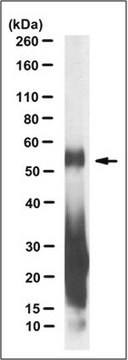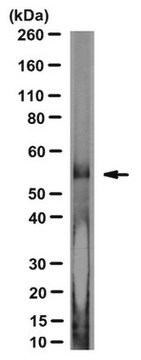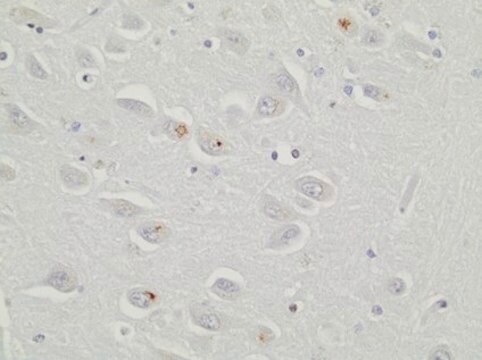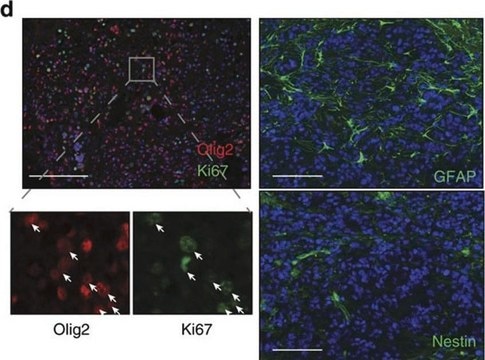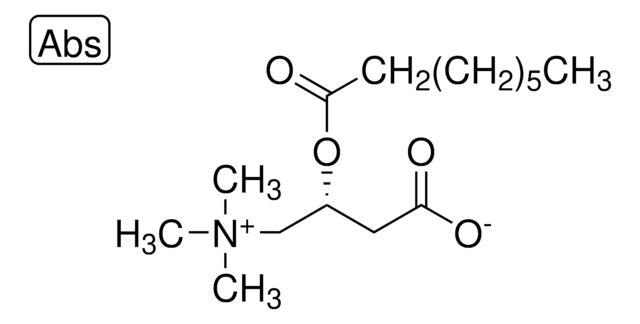ABN1354
Anti-C9ORF72/C9RANT (Poly-PR)
serum, from rabbit
Synonim(y):
C9ORF72/C9RANT (Poly-PR), alpha-PR antisense, C9ORF72 (Poly-RP)
About This Item
Polecane produkty
pochodzenie biologiczne
rabbit
Poziom jakości
forma przeciwciała
serum
rodzaj przeciwciała
primary antibodies
klon
polyclonal
reaktywność gatunkowa
human
metody
dot blot: suitable
immunofluorescence: suitable
immunohistochemistry: suitable
western blot: suitable
numer dostępu NCBI
numer dostępu UniProt
Warunki transportu
ambient
docelowa modyfikacja potranslacyjna
unmodified
informacje o genach
human ... C9orf72(203228)
Opis ogólny
Specyficzność
Immunogen
Zastosowanie
Immunofluorescence Analysis: A representative lot detected C9ORF72/C9RANT (Poly-PR) in transfected HEK293T Flag-PA cells (Zu, T., et. al. (2013). Proc. Natl. Acad. Sci. USA. 110(51):E4968-77).
Western Blotting Analysis: A representative lot detected C9ORF72/C9RANT (Poly-PR) in recombinant Protein (Zu, T., et. al. (2013). Proc. Natl. Acad. Sci. USA. 110(51):E4968-77).
Immunohistochemistry Analysis: A representative lot detected C9ORF72/C9RANT (Poly-PR) in aggregates found in neurons of the CA and DG regions of the hippocampus (Zu, T., et. al. (2013). Proc. Natl. Acad. Sci. USA. 110(51):E4968-77).
Dot Blotting Analysis: A representative lot detected C9ORF72/C9RANT (PR-CT) in Dot Blotting applications (Zu, T., et. al. (2013). Proc Natl Acad Sci USA. 110(51):E4968-77).
Neuroscience
Jakość
Western Blotting Analysis: A 1:1,000 dilution of this antibody detected C9ORF72/C9RANT (Poly-PR) in 10 µL of lysate from HEK293 cells transfected with Flag-PR.
Opis wartości docelowych
Postać fizyczna
Przechowywanie i stabilność
Inne uwagi
Oświadczenie o zrzeczeniu się odpowiedzialności
Nie możesz znaleźć właściwego produktu?
Wypróbuj nasz Narzędzie selektora produktów.
Kod klasy składowania
12 - Non Combustible Liquids
Klasa zagrożenia wodnego (WGK)
WGK 1
Certyfikaty analizy (CoA)
Poszukaj Certyfikaty analizy (CoA), wpisując numer partii/serii produktów. Numery serii i partii można znaleźć na etykiecie produktu po słowach „seria” lub „partia”.
Masz już ten produkt?
Dokumenty związane z niedawno zakupionymi produktami zostały zamieszczone w Bibliotece dokumentów.
Nasz zespół naukowców ma doświadczenie we wszystkich obszarach badań, w tym w naukach przyrodniczych, materiałoznawstwie, syntezie chemicznej, chromatografii, analityce i wielu innych dziedzinach.
Skontaktuj się z zespołem ds. pomocy technicznej
